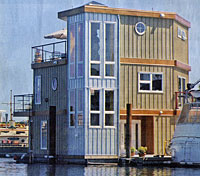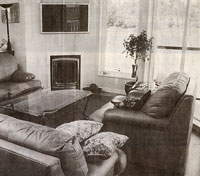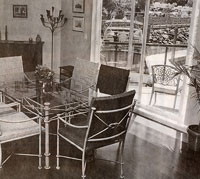|
|
|
Home /
Westbay Marine Village /
Articles of Interest /
Fabulous Float Homes with 'Aquarium' Views
Fabulous Float Homes with 'Aquarium' Views
BY DIANE DAKERS Special to Westcoast Homes Photos by Diana Nethercott/Special to Vancouver Sun Victoria Harbour view, sea life among the attractions of Esquimalt 'village' THE ISLAND | Victoria Harbour view, sea life among the attractions of Esquimalt 'village' When Dennis and Barbara Desjardins started their search for a new home a year ago, they made a list of five must-have features. "We wanted to be on or near the water, close to downtown [Victoria], have little or no maintenance, a new home and nice views," Dennis says. "But the more we tried to find that in a house, the more we recognized we'd have to spend a million or so dollars to get it." Then the couple visited the model home at Westbay Marine Village, a 26-unit floating community in Esquimalt with a view into Victoria's Inner Harbour. "It had everything we wanted," says Dennis. Plus, it was in their price range. This past January - just 10 months after signing on the dotted line, Dennis, Barbara and their 17-year-old son Max moved into a new 2,200-square-foot, three-bedroom seaside home designed just for them. The three-storey dwelling features skylights, aluminum siding, three full baths, a powder room, walk-in closets, a fireplace, two small decks on the second level and a 400-square-foot deck on the top floor, with an unobstructed view of the harbour. "It's great, it's fantastic, I wish we'd done it sooner," Dennis says of his new floating lifestyle. "The evenings are wonderful with the city lights. And we have a boat tied up off my son's bedroom. Within 45 seconds of deciding to go boating, we're boating." He also likes that their new home is low-maintenance. "I had a big smile on my face when I sold the lawnmower, the weed whacker and the hedge trimmer,' says this civil engineer, adding that the garden tools were just a few of the possessions the family had to sell before moving from their storeroom-rich, 1970s land-locked home to their new float home with its limited space for extras. I call this the little house with the big aquarium," says Dennis, who counts seals, otters, geese, herons, eagles and all kinds of water fowl among his neighbours. Of the 26 water lots at Westbay Marine Village, three (including the Desjardins') measure 1000 square feet. One small lot totals 600 square feet. The others are 754 square feet of marine surface. A 10-foot ribbon of water separates each lot from its neighbour. Right now, half the lots are leased but, so far, only seven having dwellings on them. The homes, secured to a concrete dock system, are fully serviced with water, hydro, high-speed Internet, natural gas, a sewer system,cable, telephone and fire control. Marina staff take care of dock maintenance. With amenities like these, the homes at Westbay Marine Village are a far cry from the old damp, musty "shacks on logs" some people imagine when it comes to float homes, says development manager Mark Lindholm. "There's a long history of float home living in B.C.," he says. "It goes back to the 1860s, because fishing camps, logging camps and a lot of lower-income housing in Vancouver and, to some extent, on the Island was done on float homes. Some of it was very low end. But some of it was very high end." The reason for such discrepancies in building quality was the lack of regulations governing the construction - and safety - of these houses. Over the years, as the number of ad hoc float home communities increased, so did concerns over improper sewage treatment, garbage collection, fire protection, heat and electricity hook-ups. That led to an effort by local and federal governments to eliminate - or at least control - this unregulated way of life. Enter Vancouver builder Dan Wittenberg. In the early '80s, he blazed a trail for a new style of floating community when he convinced various government agencies to allow him to develop Canoe Pass Village, a 43-home floating subdivision on the Fraser River in Ladner. He proposed building standards for float homes, with proper plumbing, electrical and fire prevention systems. He addressed financial, safety and environmental concerns. "Canoe Pass was the pioneer of true float home communities," says Lindholm. "That's what got me interested in it." Using the Canoe Pass model, Lindholm and his associates bought Victoria's Westbay Marina in 1996 on the condition that the municipality would provide services to the float homes, in exchange for property taxes, and that the federal government would agree to lease the water surface for float homes, as long as the homes met building codes. All parties agreed and eight years later, the water lots at the revamped Westbay Village went on the market. "It's just like a subdivision on land, essentially," says Lindholm. "These are top-notch, high-end homes. The only thing that distinguishes them from a home on land is that they float." The other difference is that, while residents may purchase a home to float at Westbay, they can only rent the water it bobs on. That makes it affordable. But it also makes pricing complicated. Suffice to say, a float home owner could move into Westbay for as little as $400,000. That includes an up-front payment to the marina (ranging from $50,000 to $100,000), monthly fees and the cost of building the home, which can vary wildly, depending on the design, size and materials, but generally starts around $250,000. A typical float home measures about 1,700 square feet. And it must conform to a few architectural guidelines - maximum home height at Westbay, for example, is 33 feet, with the third storey limited to 300 square feet, not counting a deck. "We encourage people to be eclectic," says Lindholm. "People that buy float homes aren't the people who buy tract homes in Another twist to float home living is that the marina - and therefore, each resident - has only 18 years left on the water lease with the federal government. "We fully expect to get renewal but the Department of Transport can't guarantee that right now," says Lindholm, adding that that's just one more consideration for those contemplating a move to the marina. "Float home people are mavericks," he says. At Westbay Marine Village, they also tend to be 50-plus couples, from the Victoria area or out-of-province, who are "fairly well off, because this is not an inexpensive first-time buyer thing." And they are people who are in it for the lifestyle, not for the investment value, says Lindholm, "because you only get to rent it." Ultimately, Westbay Marine Village will include a floating commercial contingent, with a pub, restaurant and shops. The marina is already home port for a ferry service. "It will be a mini-Granville Island concept, where you'll be right on the water with little intimate retail options, mostly catering to local residents," says Lindholm. Diane Dawson and her husband expect to move into their new Westbay float home next month. But because the community is such a friendly, tight-knit group, the Dawsons have already met their future neighbours and have been invited to dock parties. "We weren't ready for the condo lifestyle, yet," says a downsizing Dawson. "[The float home community] just felt right. We love it. It's not just the buildings. It's the people. It's the community. It's the feeling. It's a little neighbourhood." |
|||||
 |





